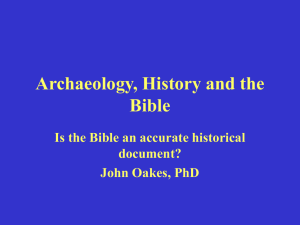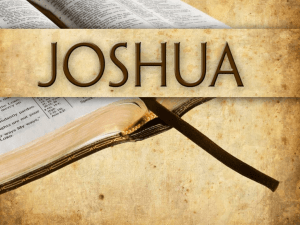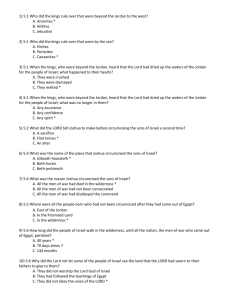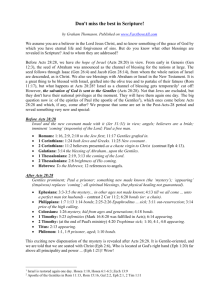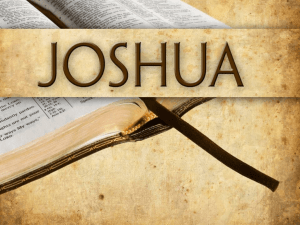History Part 1 (Bill Prichard)
advertisement
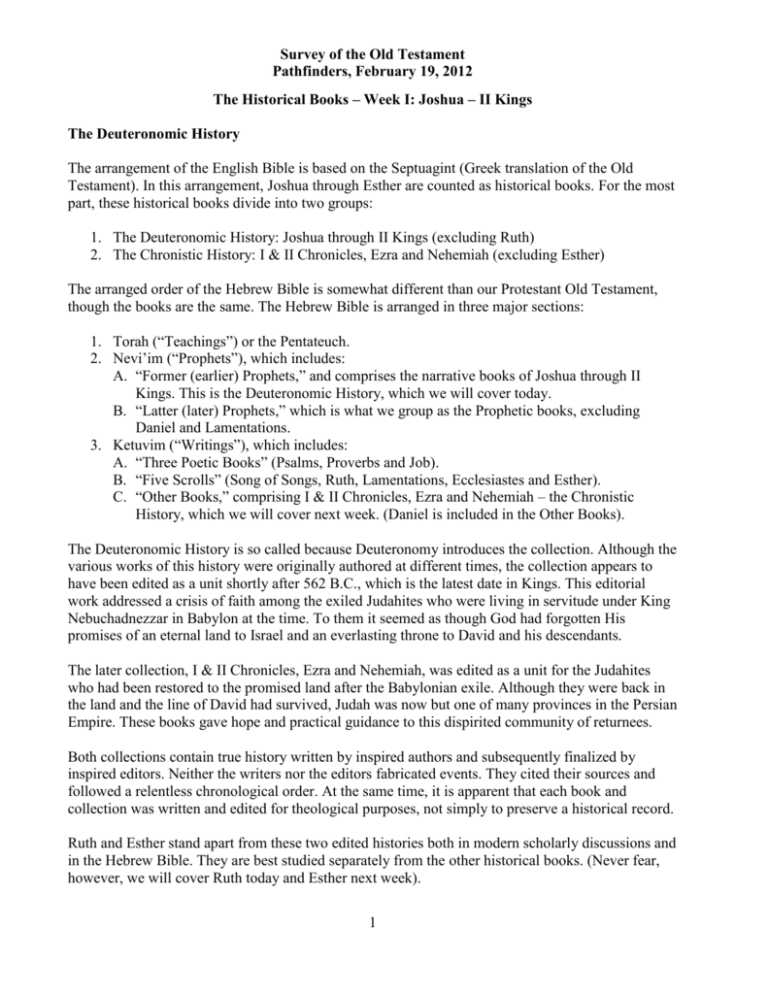
Survey of the Old Testament Pathfinders, February 19, 2012 The Historical Books – Week I: Joshua – II Kings The Deuteronomic History The arrangement of the English Bible is based on the Septuagint (Greek translation of the Old Testament). In this arrangement, Joshua through Esther are counted as historical books. For the most part, these historical books divide into two groups: 1. The Deuteronomic History: Joshua through II Kings (excluding Ruth) 2. The Chronistic History: I & II Chronicles, Ezra and Nehemiah (excluding Esther) The arranged order of the Hebrew Bible is somewhat different than our Protestant Old Testament, though the books are the same. The Hebrew Bible is arranged in three major sections: 1. Torah (“Teachings”) or the Pentateuch. 2. Nevi’im (“Prophets”), which includes: A. “Former (earlier) Prophets,” and comprises the narrative books of Joshua through II Kings. This is the Deuteronomic History, which we will cover today. B. “Latter (later) Prophets,” which is what we group as the Prophetic books, excluding Daniel and Lamentations. 3. Ketuvim (“Writings”), which includes: A. “Three Poetic Books” (Psalms, Proverbs and Job). B. “Five Scrolls” (Song of Songs, Ruth, Lamentations, Ecclesiastes and Esther). C. “Other Books,” comprising I & II Chronicles, Ezra and Nehemiah – the Chronistic History, which we will cover next week. (Daniel is included in the Other Books). The Deuteronomic History is so called because Deuteronomy introduces the collection. Although the various works of this history were originally authored at different times, the collection appears to have been edited as a unit shortly after 562 B.C., which is the latest date in Kings. This editorial work addressed a crisis of faith among the exiled Judahites who were living in servitude under King Nebuchadnezzar in Babylon at the time. To them it seemed as though God had forgotten His promises of an eternal land to Israel and an everlasting throne to David and his descendants. The later collection, I & II Chronicles, Ezra and Nehemiah, was edited as a unit for the Judahites who had been restored to the promised land after the Babylonian exile. Although they were back in the land and the line of David had survived, Judah was now but one of many provinces in the Persian Empire. These books gave hope and practical guidance to this dispirited community of returnees. Both collections contain true history written by inspired authors and subsequently finalized by inspired editors. Neither the writers nor the editors fabricated events. They cited their sources and followed a relentless chronological order. At the same time, it is apparent that each book and collection was written and edited for theological purposes, not simply to preserve a historical record. Ruth and Esther stand apart from these two edited histories both in modern scholarly discussions and in the Hebrew Bible. They are best studied separately from the other historical books. (Never fear, however, we will cover Ruth today and Esther next week). 1 Survey of the Old Testament Pathfinders, February 19, 2012 The Books Joshua Author: Unknown. Purpose: To present the fulfillments of God’s promises in the days of Joshua and to teach future generations of Israel how to serve the Lord – in battle, in distributing the promised land among the tribes and in renewing their covenant with the Lord. Date: c. 1000-561 B.C. Key Truths: 1) Through Joshua God blessed Israel with many victories in the promised land, but there were many battles yet to be fought; 2) Through Joshua God distributed the land in the way it was to be maintained in the future; and 3) The covenant renewal that took place in Joshua’s day provides a model for renewal in future generations (Joshua 24:1-28) Christ in Joshua: As the first portion of the book (1:1-12:24) presents Joshua as a warrior leading the conquest of Canaan, the New Testament speaks of Christ as the great Warrior who leads His people to take possession of the new heavens and the new earth. What Joshua merely began, Christ has fulfilled in His defeat of the devil in His first coming, is continuing to fulfill in the spiritual war now being waged through the church and will ultimately fulfill in His second coming. As the second portion of the book (13:1-21:45) focuses on the allotment of Israel’s inheritance to every tribe as God had designed, the New Testament explains that Christ gives His people their inheritance….As the third portion of the book (22:1-24:33) focuses on the necessity of faithful covenant living, the New Testament teaches that Christ fulfilled all covenant obligations for those who trust in Him so that they become the righteousness of God. Judges Author: Unknown. Purpose: To establish Israel’s need for a godly king from the line of David. Date: c. 1000-538 B.C. Key Truths: 1) The tribes of Israel failed to complete the conquest of the land and suffered from this failure; 2) God’s provision of judges could at best only temporarily bring blessings to the people of God; 3) God’s provision of the Levites also failed to bring effective leadership to God’s people; and 4) The people of God must have a godly king from Judah, not from Benjamin, to lead them. Christ in Judges: The emphasis of this book on the need for a righteous kingship from the line of David points to the role that Jesus Christ would later fulfill as king….The success of Jesus’ kingship stands in sharp contrast to the failing leadership others have provided for the people of God. Ruth Author: Unknown. Purpose: Demonstrate the legitimacy of David’s kingship despite his Moabite ancestress, Ruth. Date: c. 1000 B.C. Key Truths: 1) God’s providence is sometimes harsh, but in the end He works for the blessing of His people; 2) Familial love and devotion that are guided by God’s law bring joy and happiness; and 3) David’s family was God’s chosen, honorable, royal line. Christ in Ruth: Primarily in the way in which the book witnesses to the legitimacy of David’s kingship. As this book legitimates David, it legitimates Christ as the great Messiah. 2 Survey of the Old Testament Pathfinders, February 19, 2012 I & II Samuel Author: Unknown. The books of Samuel were originally one work that was later divided into two. Purpose: To explain that David’s dynasty remained Israel’s hope for the future in spite of the curses that David and his house had brought upon the nation. Date: 930-538 B.C. Key Truths: 1) God wanted His people to have the king He would choose; 2) God carefully prepared the way for the king of His choice; 3) God chose the house of David as the royal family forever; and 4) Despite the weakness of David’s kingdom, the hope for God’s people still remained in his family. I Samuel covers Saul’s rise and fall, and the rise to kingship of David. It includes the classic contest between David and Goliath. I Samuel 17: 45-46: “Then David said to the Philistine, ‘You come to me with a sword, with a spear, and with a javelin. But I come to you in the name of the Lord of hosts, the God of the armies of Israel, whom you have defied. This day the Lord will deliver you into my hand, and I will strike you and take your head from you. And this day I will give the carcasses of the camp of the Philistines to the birds of the air and the wild beasts of the earth, that all the earth may know that there is a God in Israel.” Fightin’ words! II Samuel covers “(1:1): After the death of Saul, David returned from defeating the Amalekites and stayed in Ziklag two days…. (1:25) How the mighty have fallen in battle!” Christ in I & II Samuel: Christ stands in contrast to the many examples of the sinful leaders of Israel who appear here. More than this, however, Jesus is the heir of David’s throne, and David’s career anticipated the person and work of Christ. I & II Kings Author: Unknown (originally one book). Purpose: To demonstrate the justice of the exile, to affirm continuing hope in David’s house and to call for repentance so that Israel might return from exile. Date: c. 560-550 B.C. Key Truths: 1) Despite the severity of the exile of Israel and Judah, God was fully justified in His wrath because of the repeated and severe apostasy of the nation; 2) God’s promises to David’s family continued despite his sons’ failures; 3) God called for His exiled people to repent of their sins; and 4) Restoration from exile was offered to Israel upon repentance. I Kings 1:1-11:43 covers Solomon’s reign; I Kings 12:1-II Kings 17:41 covers the divided monarchy, ending with the exile of the 10 tribes of Israel; II Kings 18:1-25:30 covers Judah alone. Christ in I & II Kings: First, the history stressed the family of David as the centerpiece of Israel. All hope of victory and salvation were found in God’s mercy shown to and through David’s royal house. Second, kingship and temple worship stood together in the center of this history. In fact, the kings of Israel and Judah were judged largely in terms of their loyalty or disloyalty to the temple in Jerusalem and to the purity of worship there. This motif is also fulfilled in Christ. The N.T. teaches that He is the eternal high priest for God’s people, whose own blood atoned for their sins. Source Most of the text in this handout was drawn from the Spirit of the Reformation Study Bible, Richard L. Pratt, Jr., General Editor, Zondervan, Grand Rapids, Mich., 2003. 3 Survey of the Old Testament Pathfinders, February 19, 2012 Scripture Study: Judges 21:25, Ruth 4:22, Proverbs 31:10-31 and Luke 10:1-12 Judges 21:25: In those days Israel had no king; everyone did as they saw fit. Ruth 4:18a, 22: This, then, is the family line of Perez: … Obed the father of Jesse, and Jesse the father of David. Proverbs 31:10-31: 10 A wife of noble character who can find? She is worth far more than rubies. 11 Her husband has full confidence in her and lacks nothing of value. 12 She brings him good, not harm, all the days of her life. 13 She selects wool and flax and works with eager hands. 14 She is like the merchant ships, bringing her food from afar. 15 She gets up while it is still night; she provides food for her family and portions for her female servants. 16 She considers a field and buys it; out of her earnings she plants a vineyard. 17 She sets about her work vigorously; her arms are strong for her tasks. 18 She sees that her trading is profitable, and her lamp does not go out at night. 19 In her hand she holds the distaff and grasps the spindle with her fingers. 20 She opens her arms to the poor and extends her hands to the needy. 21 When it snows, she has no fear for her household; for all of them are clothed in scarlet. 22 She makes coverings for her bed; she is clothed in fine linen and purple. 23 Her husband is respected at the city gate, where he takes his seat among the elders of the land. 24 She makes linen garments and sells them, and supplies the merchants with sashes. 25 She is clothed with strength and dignity; she can laugh at the days to come. 26 She speaks with wisdom, and faithful instruction is on her tongue. 27 She watches over the affairs of her household and does not eat the bread of idleness. 28 Her children arise and call her blessed; her husband also, and he praises her: 29 “Many women do noble things, but you surpass them all.” 30 Charm is deceptive, and beauty is fleeting; but a woman who fears the Lord is to be praised. 31 Honor her for all that her hands have done, and let her works bring her praise at the city gate. Luke 10:1-12: (Excerpted due to length) 5 “When you enter a house, first say, ‘Peace to this house.’ 6 If someone who promotes peace is there, your peace will rest on them; if not, it will return to you. 7 Stay there, eating and drinking whatever they give you, for the worker deserves his wages. Do not move around from house to house. 8 When you enter a town and are welcomed, eat what is offered to you. 9 Heal the sick who are there and tell them, ‘The kingdom of God has come near to you.’” Discussion Questions A number of themes are developed in the story of Ruth: emptiness/fullness, redemption, answered prayer, God’s hiddeness and “hesed.” Discuss how these themes have shaped your imagination. In the Christian Canon (ordering of the books) of the Bible, Ruth comes after Judges. What might the last verse of Judges (21:25) have to do with the last verse of Ruth? In the Jewish Canon, Ruth falls right after the Book of Proverbs. What might Proverbs 31:10-31 have to do with Ruth? Ruth, the outsider, is the first to show “hesed” in this story and ultimately finds herself a part of Israel. What does this do to our inside/outside categories? Read Luke 10:1-12. God’s kingdom is made in the stranger’s hospitality not the church’s. What do we do with this? Quotable Quote: “The Jews did not invent religion; they were just the first to write it down.” – Jewish Actor/Comedian Dick Shawn (1923-1987) from his one man stage show, “The Second Greatest Entertainer in the Whole Wide World.” Next Week: The Chronistic History. 4

